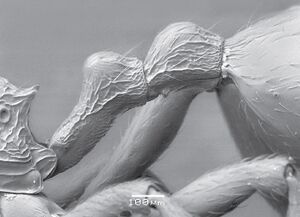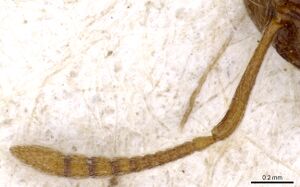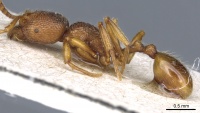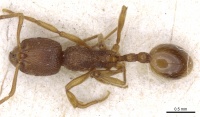Stenamma sardoum
| Stenamma sardoum | |
|---|---|

| |
| Scientific classification | |
| Kingdom: | Animalia |
| Phylum: | Arthropoda |
| Class: | Insecta |
| Order: | Hymenoptera |
| Family: | Formicidae |
| Subfamily: | Myrmicinae |
| Tribe: | Stenammini |
| Genus: | Stenamma |
| Species: | S. sardoum |
| Binomial name | |
| Stenamma sardoum Emery, 1915 | |
Seemingly this is a Sardinian endemic, but maybe it occurs also in Corsica (Rigato & Toni, 2011).
Identification
Rigato (2011) - This species has no unique strong diagnostic features, but, besides its distribution, it is recognisable by the following combination of worker characters: the values of SI (usually ≥ 90) and PCI (range: 25–34) plus relatively low and elongate postpetiole and irregular promesonotal sculpturation. The gyne is similar, except for the sculpturation.
At a glance sardoum female castes were easily separated from co-occurring specimens of debile because females of sardoum are mostly ferrugineous, distinctly paler than the brown debile, even though colour differences are generally considered unreliable. Also, in sardoum petiolar and postpetiolar sternites in profile look distinctly, although weakly, more concave below the nodes. In contrast, the waist sternites of Stenamma debile are only faintly concave at most. This difference is easier to appreciate when specimens of both species are compared directly. Stenamma sardoum female castes generally look similar to Stenamma westwoodii. Diagnostic features useful to separate them are difficult to appreciate and rely on difference in PCI, promesonotal sculpturation and shape of postpetiole.
Keys including this Species
- Key to Oriental and Palearctic Stenamma
- Key to Stenamma westwoodii species-group males of Western Europe and North African
- Key to Stenamma westwoodii species-group queens of Western Europe and North African
- Key to Stenamma westwoodii species-group workers of Western Europe and North African
Distribution
Seemingly a relatively common Sardinian endemic. (Rigato 2011)
Latitudinal Distribution Pattern
Latitudinal Range: 41.303056° to 39.35443379°.
| North Temperate |
North Subtropical |
Tropical | South Subtropical |
South Temperate |
- Source: AntMaps
Distribution based on Regional Taxon Lists
Palaearctic Region: Italy (type locality), Malta.
Distribution based on AntMaps
Distribution based on AntWeb specimens
Check data from AntWeb
Countries Occupied
| Number of countries occupied by this species based on AntWiki Regional Taxon Lists. In general, fewer countries occupied indicates a narrower range, while more countries indicates a more widespread species. |

|
Estimated Abundance
| Relative abundance based on number of AntMaps records per species (this species within the purple bar). Fewer records (to the left) indicates a less abundant/encountered species while more records (to the right) indicates more abundant/encountered species. |

|
Biology
Castes
Worker
     
| |
| . | |
Queen
  
| |
| . | |
Nomenclature
The following information is derived from Barry Bolton's Online Catalogue of the Ants of the World.
- sardoum. Stenamma sardoum Emery, 1915a: 255, pl. 4, figs. 5, 6 (w.q.) ITALY (Sardinia).
- Type-material: lectotype worker (by designation of DuBois, 1998b: 237), 3 paralectotype workers, 1 paralectotype queen.
- Type-locality: lectotype Italy: Sardinia, Aritzo, xi.1911 (D. Dodero); paralectotypes with same data.
- [Note: the syntype queen discussed by Emery could not be found by DuBois, 1998b: 238, but Rigato, 2011: 11, records paralectotypes as 3 workers, 1 queen.]
- Type-depository: MSNG.
- Status as species: Bondroit, 1918: 149; Emery, 1921f: 53; Müller, 1923b: 45 (in key); Grandi, 1935: 99; Bernard, 1967: 127 (redescription); Collingwood & Yarrow, 1969: 59; Baroni Urbani, 1971c: 38; Collingwood, 1978: 80 (in key); Agosti & Collingwood, 1987b: 269 (in key); Casevitz-Weulersse, 1990b: 137; Bolton, 1995b: 394; Poldi, et al. 1995: 3; Espadaler, 1997b: 31; DuBois, 1998b: 237 (redescription); Petrov, 2006: 89 (in key); Liu, X. & Xu, 2011: 737 (in key); Rigato, 2011: 11 (redescription); Bharti, Gul & Sharma, 2012a: 326 (in key); Borowiec, L. 2014: 161; Lebas, et al. 2016: 336.
- Distribution: Italy.
Unless otherwise noted the text for the remainder of this section is reported from the publication that includes the original description.
Emery (1915) described Stenamma sardoum on the basis of a few workers and one gyne, comparing it with Stenamma westwoodii of earlier authors (i.e. specimens now known to be Stenamma debile) and pointed out the strong difference in the shape of the petiolar node that he described as truncate in profile. Actually, Emery was quite wrong in reporting such a feature, even adding a misleading figure. I examined the type series and several other specimens of S. sardoum and all of them have an ordinary, somewhat rounded node in profile with a faint flattening at most. DuBois (1998) designated the lectotype and redescribed S. sardoum. In his keys he stated that the petiolar node was “depressed”. Nevertheless his drawings showed a petiolar profile comparable to that of most Stenamma.
Description
Worker
Rigato (2011) - Lectotype (designated by DuBois (1998)): TL 3.6; HL 0.87; HW 0.72; CI 83; SL 0.66; SI 92; PnW 0.48; AL 1.00; PeL 0.38; PPL 0.26; PeH 0.20; PPH 0.21; PeW 0.16; PPW 0.21; PI1 68; PI2 53; MTL 0.61; TI 85.
Paralectotype: TL 3.6–3.9; HL 0.86–0.91; HW 0.72–0.77; CI 84–85; SL 0.67–0.70; SI 89–93; PnW 0.48–0.51; AL 1.04–1.10; PeL 0.38–0.42; PPL 0.26–0.29; PeH 0.20–0.23; PPH 0.21–0.23; PeW 0.15–0.18; PPW 0.20–0.23; PI1 68–69; PI2 53–55; MTL 0.61–0.65; TI 84–86 (3 measured).
TL 3.3–4.3; HL 0.81–0.91; HW 0.67–0.76; CI 82–85; SL 0.63–0.70; SI 89–96; PCI 25–34; PnW 0.43–0.51; AL 0.95–1.11; PSI 1.58–1.88; PeL 0.37–0.42; PPL 0.23–0.27; PeH 0.19–0.22; PPH 0.18–0.22; PeW 0.15–0.17; PPW 0.19–0.23; PI1 62–69; PI2 51–57; MTL 0.56–0.65; TI 81–89 (17 measured).
Queen
Rigato (2011) - Paralectotype: TL 4.5; HL 0.95; HW 0.82; CI 86; SL 0.74; SI 90; ScW 0.64; MnL 1.01; PeL 0.48; PPL 0.33; PeH 0.25; PPH 0.26; PeW 0.20; PPW 0.28; PI1 69; PI2 59; MTL 0.72; TI 88.
TL 4.4–5.0; HL 0.92–1.01; HW 0.79–0.85; CI 84–86; SL 0.71–0.76; SI 89–90; PCI 30–34; AL 1.28–1.40; PSI 1.60–2.10; ScW 0.64–0.68; MnL 0.92–1.01; PeL 0.47–0.50; PPL 0.31–0.33; PeH 0.25; PPH 0.24–0.26; PeW 0.20–0.21; PPW 0.26–0.28; PI1 66; PI2 59; MTL 0.66–0.73; TI 84–86 (2 measured).
Type Material
Rigato (2011) - Lectotype worker, paralectotype workers and gyne, ITALY: SARDINIA, Aritzo, xi.1911 (D. Dodero) (Museo Civico di Storia Naturale, Genoa) [examined].
Determination Clarifications
Rigato (2011) - X. Espadaler (pers. comm.) has assigned the single specimen reported from Spain by Collingwood and Yarrow (1969) to Stenamma debile.
References
- Bharti, H.; Gul, I.; Sharma, Y. P. 2012. Two new species of Stenamma (Hymenoptera: Formicidae) from Indian Himalaya with a revised key to the Palaearctic and Oriental species. Sociobiology. 59:317-330.
- Rigato, F. 2011. Contributions to the taxonomy of West European and North African Stenamma of the westwoodii species-group. (Hymenoptera Formicidae). Memorie della Società Italiana di Scienze Naturali e del Museo Civico di Storia Naturale di Milano. 37:1-56.
- Arcos, J., Chaves, D., Alarcón, P., Rosado, A. 2022. First record of Temnothorax convexus (Forel, 1894) in Portugal (Hymenoptera: Formicidae) with an updated checklist of the ants from the country. Sociobiology, 69(2), e7623 (doi:10.13102/sociobiology.v69i2.7623).
- Arcos, J., Chaves, D., Alarcón, P., Rosado, Á. 2022. First record of Temnothorax convexus (Forel, 1894) in Portugal (Hymenoptera: Formicidae) with an updated checklist of the ants from the country. Sociobiology, 692), e7623 (doi:10.13102/sociobiology.v69i2.7623).
- Borowiec, L. 2014. Catalogue of ants of Europe, the Mediterranean Basin and adjacent regions (Hymenoptera: Formicidae). Genus (Wroclaw) 25(1-2): 1-340.
- DuBois, M. B. 1998a. A revision of the ant genus Stenamma in the Palaearctic and Oriental regions (Hymenoptera: Formicidae: Myrmicinae). Sociobiology 29: 193-403 (page 237, see also)
- Emery, C. 1915a. Contributo alla conoscenza delle formiche delle isole italiane. Descrizione di forme mediterrannee nuove o critiche. Ann. Mus. Civ. Stor. Nat. 46[=(3)(6): 244-270 (page 255, pl. 4, figs. 5, 6 worker, queen described)
- Rigato, F.; Toni, I. 2011. Short notes 21. Hymenoptera, Formicidae. Pp. 873-882 in: Nardi, G.; Whitmore, D.; Bardiani, M.; Birtele, D.; Mason, F.; Spada, L.; Cerretti, P. (eds.) 2011. Biodiversity of Marganai and Montimannu (Sardinia). Research in the framework of the ICP Forests network. Conservazione Habitat Invertebrati, 5. Sommacampagna, Verona: Cierre Edizioni, 896 pp.
- Schifani, E., Nalini, E., Gentile, V., Alamanni, F., Ancona, C., Caria, M., Cillo, D., Bazzato, E. 2021. Ants of Sardinia: An updated checklist based on new faunistic, morphological and biogeographical notes. Redia 104, 21–35 (doi:10.19263/redia-104.21.03).
References based on Global Ant Biodiversity Informatics
- Bernard F. 1967. Faune de l'Europe et du Bassin Méditerranéen. 3. Les fourmis (Hymenoptera Formicidae) d'Europe occidentale et septentrionale. Paris: Masson, 411 pp.
- Borowiec L. 2014. Catalogue of ants of Europe, the Mediterranean Basin and adjacent regions (Hymenoptera: Formicidae). Genus (Wroclaw) 25(1-2): 1-340.
- Branstetter M. G. 2012. Origin and diversification of the cryptic ant genus Stenamma Westwood (Hymenoptera: Formicidae), inferred from multilocus molecular data, biogeography and natural history. Systematic Entomology 37: 478-496.
- DuBois, M. B. "A revision of the ant genus Stenamma in the Palaeartic and Oriental regions." Sociobiology 32 (1998): 193-403.
- Emery C. 1916. Fauna entomologica italiana. I. Hymenoptera.-Formicidae. Bullettino della Società Entomologica Italiana 47: 79-275.
- Grandi G. 1935. Contributi alla conoscenza degli Imenotteri Aculeati. XV. Boll. R. Ist. Entomol. Univ. Studi Bologna 8: 27-121.
- Liu X., and Z. H. Xu. 2011. Three New Species of the Ant Genus Stenamma (Hymenoptera: Formicidae) from Himalaya and the Hengduan Mountains With a Revised Key to the Known Species of the Palaearctic and Oriental Regions. Sociobiology 58: 733-748.
- Poldi B., M. Mei, and F. Rigato. 1995. Hymenoptera, Formicidae. Vol 102. Checklist delle specie della fauna Italiana: 1-10.
- Rigato F. 2011. Contributions to the taxonomy of West European and North African Stenamma of the westwoodii species-group. (Hymenoptera Formicidae). Memorie della Società Italiana di Scienze Naturali e del Museo Civico di Storia Naturale di Milano 37: 1-56.
- Rigato S., and I. Toni. 2011. Short notes 21. Hymenoptera, Formicidae. Pp. 873-882 in: Nardi, G.; Whitmore, D.; Bardiani, M.; Birtele, D.; Mason, F.; Spada, L.; Cerretti, P. (eds.) 2011. Biodiversity of Marganai and Montimannu (Sardinia). Research in the framework of the ICP Forests network. Conservazione Habitat Invertebrati, 5. Sommacampagna, Verona: Cierre Edizioni, 896 pp.

